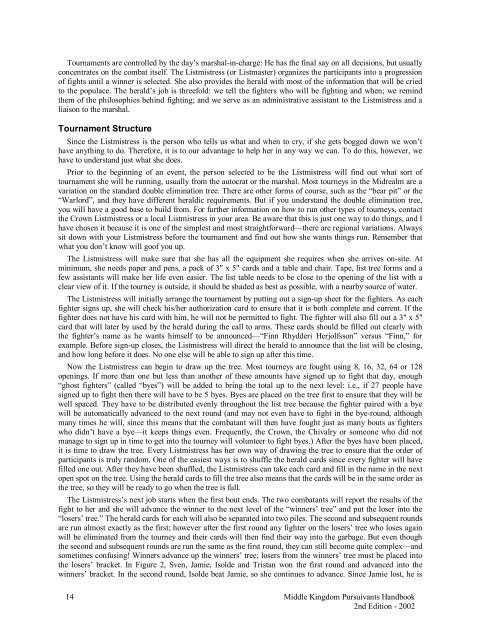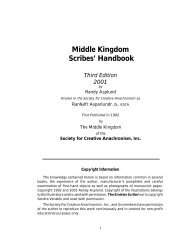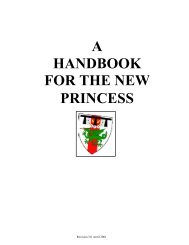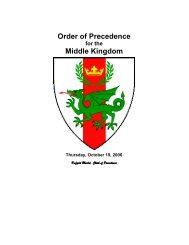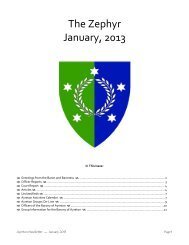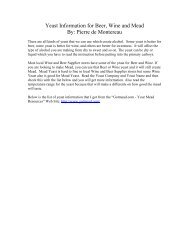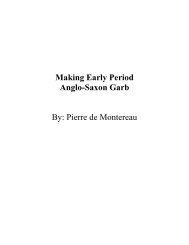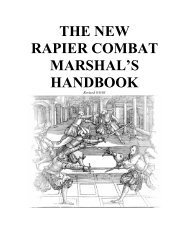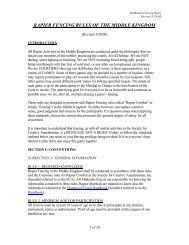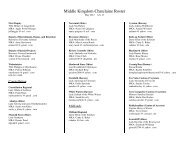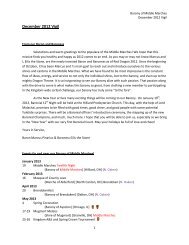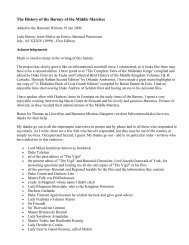Middle Kingdom Pursuivants Handbook 2nd Edition - Midrealm ...
Middle Kingdom Pursuivants Handbook 2nd Edition - Midrealm ...
Middle Kingdom Pursuivants Handbook 2nd Edition - Midrealm ...
Create successful ePaper yourself
Turn your PDF publications into a flip-book with our unique Google optimized e-Paper software.
Tournaments are controlled by the day’s marshal-in-charge: He has the final say on all decisions, but usuallyconcentrates on the combat itself. The Listmistress (or Listmaster) organizes the participants into a progressionof fights until a winner is selected. She also provides the herald with most of the information that will be criedto the populace. The herald’s job is threefold: we tell the fighters who will be fighting and when; we remindthem of the philosophies behind fighting; and we serve as an administrative assistant to the Listmistress and aliaison to the marshal.Tournament StructureSince the Listmistress is the person who tells us what and when to cry, if she gets bogged down we won’thave anything to do. Therefore, it is to our advantage to help her in any way we can. To do this, however, wehave to understand just what she does.Prior to the beginning of an event, the person selected to be the Listmistress will find out what sort oftournament she will be running, usually from the autocrat or the marshal. Most tourneys in the <strong>Midrealm</strong> are avariation on the standard double elimination tree. There are other forms of course, such as the “bear pit” or the“Warlord”, and they have different heraldic requirements. But if you understand the double elimination tree,you will have a good base to build from. For further information on how to run other types of tourneys, contactthe Crown Listmistress or a local Listmistress in your area. Be aware that this is just one way to do things, and Ihave chosen it because it is one of the simplest and most straightforward—there are regional variations. Alwayssit down with your Listmistress before the tournament and find out how she wants things run. Remember thatwhat you don’t know will goof you up.The Listmistress will make sure that she has all the equipment she requires when she arrives on-site. Atminimum, she needs paper and pens, a pack of 3" x 5" cards and a table and chair. Tape, list tree forms and afew assistants will make her life even easier. The list table needs to be close to the opening of the list with aclear view of it. If the tourney is outside, it should be shaded as best as possible, with a nearby source of water.The Listmistress will initially arrange the tournament by putting out a sign-up sheet for the fighters. As eachfighter signs up, she will check his/her authorization card to ensure that it is both complete and current. If thefighter does not have his card with him, he will not be permitted to fight. The fighter will also fill out a 3" x 5"card that will later by used by the herald during the call to arms. These cards should be filled out clearly withthe fighter’s name as he wants himself to be announced—“Finn Rhydderi Herjolfsson” versus “Finn,” forexample. Before sign-up closes, the Listmistress will direct the herald to announce that the list will be closing,and how long before it does. No one else will be able to sign up after this time.Now the Listmistress can begin to draw up the tree. Most tourneys are fought using 8, 16, 32, 64 or 128openings. If more than one but less than another of these amounts have signed up to fight that day, enough“ghost fighters” (called “byes”) will be added to bring the total up to the next level: i.e., if 27 people havesigned up to fight then there will have to be 5 byes. Byes are placed on the tree first to ensure that they will bewell spaced. They have to be distributed evenly throughout the list tree because the fighter paired with a byewill be automatically advanced to the next round (and may not even have to fight in the bye-round, althoughmany times he will, since this means that the combatant will then have fought just as many bouts as fighterswho didn’t have a bye—it keeps things even. Frequently, the Crown, the Chivalry or someone who did notmanage to sign up in time to get into the tourney will volunteer to fight byes.) After the byes have been placed,it is time to draw the tree. Every Listmistress has her own way of drawing the tree to ensure that the order ofparticipants is truly random. One of the easiest ways is to shuffle the herald cards since every fighter will havefilled one out. After they have been shuffled, the Listmistress can take each card and fill in the name in the nextopen spot on the tree. Using the herald cards to fill the tree also means that the cards will be in the same order asthe tree, so they will be ready to go when the tree is full.The Listmistress’s next job starts when the first bout ends. The two combatants will report the results of thefight to her and she will advance the winner to the next level of the “winners’ tree” and put the loser into the“losers’ tree.” The herald cards for each will also be separated into two piles. The second and subsequent roundsare run almost exactly as the first; however after the first round any fighter on the losers’ tree who loses againwill be eliminated from the tourney and their cards will then find their way into the garbage. But even thoughthe second and subsequent rounds are run the same as the first round, they can still become quite complex—andsometimes confusing! Winners advance up the winners’ tree; losers from the winners’ tree must be placed intothe losers’ bracket. In Figure 2, Sven, Jamie, Isolde and Tristan won the first round and advanced into thewinners’ bracket. In the second round, Isolde beat Jamie, so she continues to advance. Since Jamie lost, he is14 <strong>Middle</strong> <strong>Kingdom</strong> <strong>Pursuivants</strong> <strong>Handbook</strong><strong>2nd</strong> <strong>Edition</strong> - 2002


